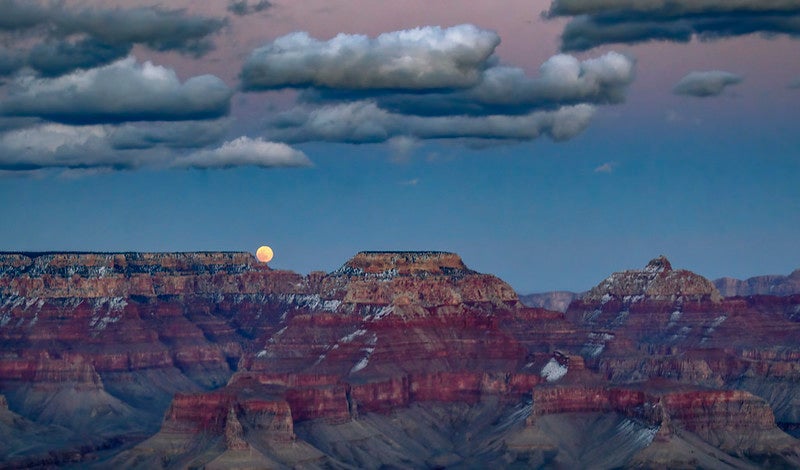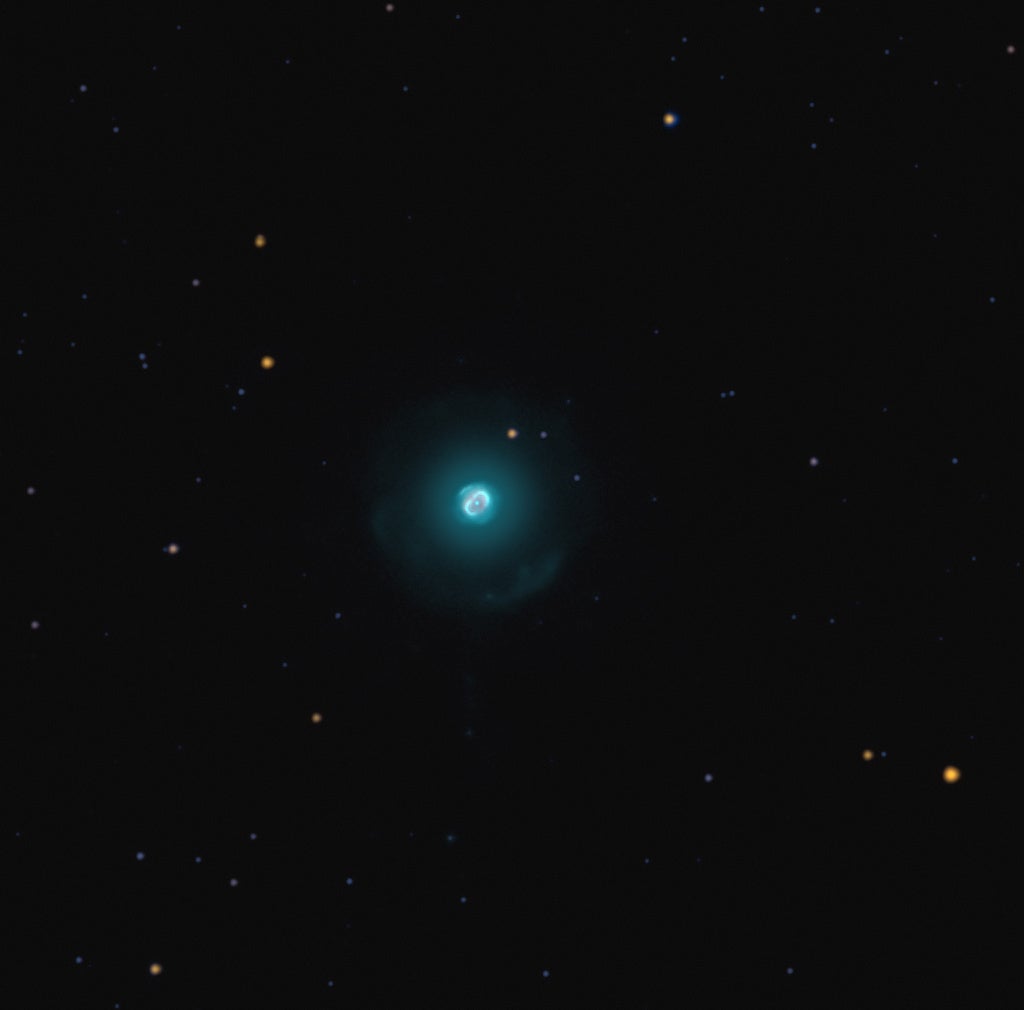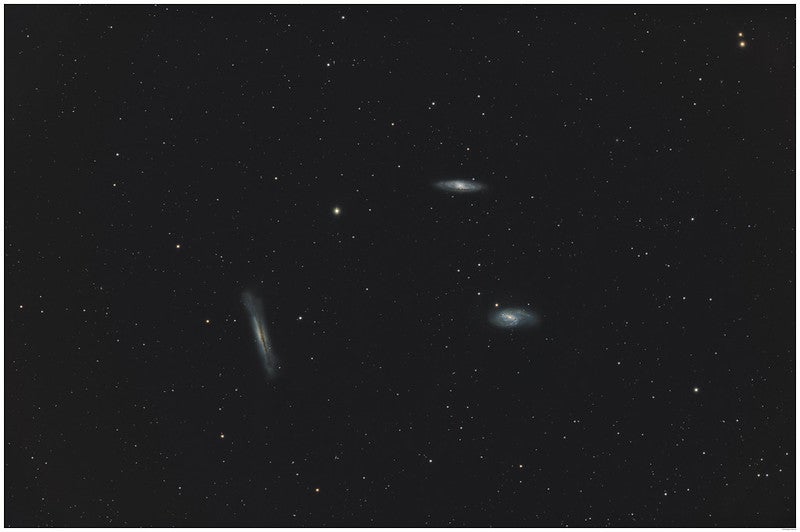
Friday, February 23
A Full Moon rises opposite the setting Sun this evening, riding into the sky beneath the body of Leo the Lion. Luna sits within 3° of the lion’s bright heart, Regulus, a 1st-magnitude star that lies close to the ecliptic plane that the Moon and planets follow through our sky. In fact, the Moon sometimes occults, or passes in front of, Regulus, though the alignment isn’t right this month.
In the south after sunset is Canis Major, its alpha star Sirius unmistakable. This is the brightest star in the sky, shining at magnitude –1.4. About 10° east-southeast of this luminary is our target for tonight: a seemingly innocuous star labeled simply as 145 Canis Majoris. Zoom in with some optics and you’ll discover a treat: It’s not one star, but two, with contrasting colors of orange-yellow and blue-white. 145 Cma is sometimes called the Winter Albireo, for its resemblance to a similar contrasting-color binary in Cygnus the Swan (the original Albireo) that is visible in the summertime night sky. Astronomy contributor Phil Harrington says he’s split the pair with 16×70 binoculars, or a telescope of any size will do the trick.
Sunrise: 6:42 A.M.
Sunset: 5:45 P.M.
Moonrise: 5:03 P.M.
Moonset: 6:38 A.M.
Moon Phase: Waxing gibbous (99%)
*Times for sunrise, sunset, moonrise, and moonset are given in local time from 40° N 90° W. The Moon’s illumination is given at 12 P.M. local time from the same location.
Saturday, February 24
Full Moon officially occurs at this morning at 7:30 A.M. EST. The February Full Moon is also known as the Snow Moon, given the cold weather North America typically experiences at this time of year.
You may have heard of a Super Moon, when Luna appears bigger and brighter in the sky than average, but this month’s Full Moon is the opposite: a Micro Moon! The Moon is nearing its apogee, the farthest point from Earth in its orbit, which it will reach in just over 24 hours. So, the Full Moon may appear just a bit smaller and dimmer than usual. However, the difference will be hard to notice!
With the Moon still in Leo and rising in the east after dark, let’s turn to the west, where the constellation Auriga is still high in the sky. The Charioteer hosts a number of stunning star clusters, and tonight we’re homing in on M38, an open cluster also known as the Starfish Cluster.
You’ll find M38 just under 10.5° south-southeast of the constellation’s brightest star, Capella. The open cluster spans about 21′ and shines at magnitude 7.4; it’s best seen with binoculars or a low-powered scope. Less than 1.5° to its south is the 5th-magnitude star Phi (ϕ) Aurigae. Phi is surrounded by IC 405, also called the Flaming Star Nebula. This faint nebula is visible with a telescope under dark skies, but Luna’s bright light will likely wash it out even for larger apertures today. Instead, plan to return when the Moon is New for a better chance at picking up this glowing gas.
Sunrise: 6:41 A.M.
Sunset: 5:46 P.M.
Moonrise: 6:03 P.M.
Moonset: 7:02 A.M.
Moon Phase: Full
Sunday, February 25
As mentioned in yesterday’s entry, the Moon reaches apogee, the farthest point from Earth in its orbit, at 9:59 A.M. EST. At that time, our satellite will sit some 252,470 miles (406,311 kilometers) away. Still roughly 99 percent lit, the Moon will also appear Full for one more night.
An hour after sunset, bright Jupiter still stands some 50° high in the west. It’s the brightest object in the region, far outshining the stars in this part of the sky. Jupiter sits in Aries the Ram, sharing the constellation with Uranus — which, at magnitude 5.8, is at the edge of naked-eye visibility and better picked up with binoculars or a telescope.
You’ll want that telescope tonight to catch a transit of Jupiter’s largest moon, Ganymede, as it passes in front of the gas giant’s south polar region. The transit begins around 8:30 P.M. EST, as Ganymede moves onto the eastern limb. Io lies farther east, while Europa (closer) and Callisto are to the planet’s west. Ganymede’s journey lasts roughly two hours, ending around 10:30 P.M. EST, when the planet is very low for observers on the East Coast but more readily visible for those farther west. The moon’s shadow won’t appear for its own crossing before the planet has set for all time zones in the continental U.S.
Sunrise: 6:40 A.M.
Sunset: 5:47 P.M.
Moonrise: 7:03 P.M.
Moonset: 7:22 A.M.
Moon Phase:
Moon Phase: Waning gibbous (99%)

Monday, February 26
There’s a short dark window tonight when you may be able to catch Comet 12P/Pons-Brooks, sailing through southwestern Andromeda low in the northwest. After the sky grows dark but before moonrise, swing your scope over to the Princess to look for the comet, recently recorded around magnitude 7, some 7.3° southeast of magnitude 3.6 Omicron (ο) Andromedae.
Through the eyepiece of your telescope, the comet will look like a small, round, white fuzzball. Imagers may be able to pick up the green glow of its diatomic carbon. Pons-Brooks is now about 1.7 astronomical units from Earth, or 158 million miles (254 million km). It will round the Sun, making its closest approach of our star, in late April.
As a bonus, swing your scope about 6.2° due north of the comet this evening to find NGC 7662, also known as the Blue Snowball. This planetary nebula also appears like a round, fuzzy ball — but this time, the blue hue for which it’s named might be visible. At magnitude 9, it’s a bit fainter than the comet, though the nebula’s small size of about 2′ helps to concentrate its light and better bring out the color.
Sunrise: 6:38 A.M.
Sunset: 5:48 P.M.
Moonrise: 8:02 P.M.
Moonset: 7:42 A.M.
Moon Phase: Waning gibbous (96%)
Tuesday, February 27
The constellation Scorpius lies due south an hour before sunrise, home to the beautiful open star cluster M7, also called Ptolemy’s Cluster or the Scorpion’s Tail. The latter name should hint at its location, about 5° east-northeast of Shaula (Lambda [λ] Scorpii) and Lesath (Upsilon [υ] Scorpii), called the stinger stars for their location at the tip of Scorpius’ curving tail.
The magnitude 3.3 cluster is visible to the naked eye under good, dark conditions, while binoculars and telescopes of any size will bring out myriad stars. Spanning roughly 80′, the young group of stars contains some 80 to 100 members, with many more unrelated stars in the field of view, adding to its richness.
Jump just 4° northwest of M7 and you’ll land on a second open cluster, M6. Smaller (25′ across) and dimmer (magnitude 4.2), M6 is often called the Butterfly Cluster because some observers think its stars taken together look like a butterfly with outstretched wings. Astronomers think M6 may be related to M7, but even if the two formed together, M6 is now much farther from Earth, about twice the distance of M7.
Sunrise: 6:37 A.M.
Sunset: 5:49 P.M.
Moonrise: 9:02 P.M.
Moonset: 8:01 A.M.
Moon Phase: Waning gibbous (91%)

Wednesday, February 28
Mercury reaches superior conjunction at 4 A.M. EST, placing it on the other side of the Sun from Earth and rendering it invisible. The solar system’s smallest planet will move into the evening sky early next month.
Saturn also reaches conjunction with the Sun 12 hours later, at 4 P.M. EST, and will appear in the morning sky by late March.
Now that the Moon is rising later, let’s go back to Leo to search out the famous Leo Trio, a group of three spiral galaxies about 7° west of Denebola, the 2nd-magnitude star that marks the Lion’s tail. The region is about 30° high within three hours of sunset.
The Trio consists of M65, M66, and NGC 3628. The first two lie roughly on an east-west line, with M66 to the east and M65 to the west. Both are roughly 9th magnitude and about 8′ across at their long axis. NGC 3628 lies about 1° north of the pair. It’s about half a magnitude fainter and nearly twice as long, making it slightly more difficult to spot. This may be why the first two made Charles Messier’s cut, but the third galaxy was not discovered until a few years later by William Herschel.
Sunrise: 6:35 A.M.
Sunset: 5:51 P.M.
Moonrise: 10:02 P.M.
Moonset: 8:20 A.M.
Moon Phase: Waning gibbous (85%)
Thursday, February 29
Today is a leap day, adding an “extra” day to the month of February to make up for the fact that the period of Earth’s orbit doesn’t match the calendar year exactly. It takes Earth about 365.25 days to circle the Sun, but our calendar only has 365 days. So, every four years, that extra 0.25 day adds up to a full day and we celebrate a leap year. (Reality is, as often, a little more complex than that — check out this article for more details on exactly how we account for the difference!)
Following their conjunction last week, Mars and Venus have put some space between themselves and are now about 3.4° apart in the morning sky. Step outside about 30 minutes before sunrise to catch them some 5° high in the east.
Venus is brighter at magnitude –3.9, an unmissable morning star. Mars is magnitude 1.2 and may be a bit challenging in the growing twilight. Try using binoculars or a telescope to find it, to the upper right (west) of Venus in the sky. Through your optics, you may note that Venus is 11″ across and in a clear gibbous phase, some 91 percent lit. Mars is just 4″ wide and roughly full at 97 percent lit. Above the pair, you may notice some brighter stars before they wink out in the twilight. Altair lies directly above the planetary pair, with Deneb to its far upper left and Vega to Deneb’s upper right.
Make sure you put away any binoculars or telescopes at least several minutes before sunrise at your location, which may differ slightly from the time given below.
Sunrise: 6:34 A.M.
Sunset: 5:52 P.M.
Moonrise: 11:05 P.M.
Moonset: 8:42 A.M.
Moon Phase: Waning gibbous (77%)
Friday, March 1
Let’s catch a second comet this week! Comet C/2021 S3 (PanSTARRS) is for early risers; and, at magnitude 10, it’s fainter than Pons-Brooks. PanSTARRS is now in Serpens Cauda, rising in the southeast in the hour or two before dawn. You can find it just under 3.5° southwest of magnitude 3.2 Alava, in a region that lies to the upper right of the bright star Altair in Aquila the Eagle. If you draw a line between Altair and Antares in Scorpius, PanSTARRS sits roughly halfway between these two stars.
This whole region of the sky lies near the plane of the Milky Way. If you’re lucky enough to live in — or observe from — a particularly dark location, you’ll likely see the soft glow from numerous stars as well as the dark swaths of dust that blanket the plane of the galaxy. Note that the waning Moon lies in Libra this morning, which may somewhat wash out the gentle glow of the galactic plane. Fortunately, the comet will remain in this part of the sky as an excellent early-morning target, so you can simply wait a few days for the Moon to pass through and try for PanSTARRS — and the Milky Way — again.
Sunrise: 6:32 A.M.
Sunset: 5:53 P.M.
Moonrise: —
Moonset: 9:08 A.M.
Moon Phase: Waning gibbous (69%)

Sky This Week is brought to you in part by Celestron.









